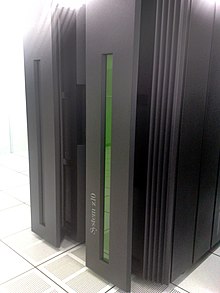IBM mainframes are large computer systems produced by IBM since 1952. During the 1960s and 1970s, IBM dominated the computer market with the 7000 series and the later System/360, followed by the System/370. Current mainframe computers in IBM's line of business computers are developments of the basic design of the System/360.

Multiple Virtual Storage, more commonly called MVS, is the most commonly used operating system on the System/370, System/390 and IBM Z IBM mainframe computers. IBM developed MVS, along with OS/VS1 and SVS, as a successor to OS/360. It is unrelated to IBM's other mainframe operating system lines, e.g., VSE, VM, TPF.

VSEn is an operating system for IBM mainframe computers, the latest one in the DOS/360 lineage, which originated in 1965. It is less common than z/OS and is mostly used on smaller machines.

Db2 is a family of data management products, including database servers, developed by IBM. It initially supported the relational model, but was extended to support object–relational features and non-relational structures like JSON and XML. The brand name was originally styled as DB2 until 2017, when it changed to its present form.
In computing, Interactive System Productivity Facility (ISPF) is a software product for many historic IBM mainframe operating systems and currently the z/OS and z/VM operating systems that run on IBM mainframes. It includes a screen editor, the user interface of which was emulated by some microcomputer editors sold commercially starting in the late 1980s, including SPF/PC.
Time Sharing Option (TSO) is an interactive time-sharing environment for IBM mainframe operating systems, including OS/360 MVT, OS/VS2 (SVS), MVS, OS/390, and z/OS.
Job Control Language (JCL) is a name for scripting languages used on IBM mainframe operating systems to instruct the system on how to run a batch job or start a subsystem. The purpose of JCL is to say which programs to run, using which files or devices for input or output, and at times to also indicate under what conditions to skip a step. Parameters in the JCL can also provide accounting information for tracking the resources used by a job as well as which machine the job should run on.

IBM CICS is a family of mixed-language application servers that provide online transaction management and connectivity for applications on IBM mainframe systems under z/OS and z/VSE.
z/OS UNIX System Services is a base element of z/OS. z/OS UNIX is a certified UNIX operating system implementation optimized for mainframe architecture. It is the first UNIX 95 to not be derived from the AT&T source code. Through integration with the rest of z/OS, additional Time Sharing Option (TSO) commands are available alongside the usual UNIX services, making it possible to process UNIX files using ISPF. Extensions in JCL make it possible to use these files in batch processing.
In the context of IBM mainframe computers in the S/360 line, a data set or dataset is a computer file having a record organization. Use of this term began with, e.g., DOS/360, OS/360, and is still used by their successors, including the current z/OS. Documentation for these systems historically preferred this term rather than file.
The IBM System z Application Assist Processor (zAAP), previously known as the zSeries Application Assist Processor, is a mainframe processor introduced by IBM in 2004. zAAP engines are dedicated to running specific Java and XML workloads under z/OS, accelerating performance. zAAPs are available for zSeries 990 and 890 servers and later zSeries and zEnterprise models. Beginning with the IBM z13, the zAAP functionality is integrated with zIIP processors.
The Job Entry Subsystem (JES) is a component of IBM's MVS mainframe operating systems that is responsible for managing batch workloads. In modern times, there are two distinct implementations of the Job Entry System called JES2 and JES3. They are designed to provide efficient execution of batch jobs.
In computing, a Parallel Sysplex is a cluster of IBM mainframes acting together as a single system image with z/OS. Used for disaster recovery, Parallel Sysplex combines data sharing and parallel computing to allow a cluster of up to 32 systems to share a workload for high performance and high availability.

IBM System z9 is a line of IBM mainframe computers. The first models were available on September 16, 2005. The System z9 also marks the end of the previously used eServer zSeries naming convention. It was also the last mainframe computer that NASA ever used.

The System Display and Search Facility (SDSF) is a component of IBM's mainframe operating system, z/OS, is an interactive user interface that allows users and administrators to view and control various aspects of the mainframe's operation and system resources. Some of the information displayed in SDSF includes Batch job output, Unix processes, scheduling environments, and the status of external devices such as printers and network lines, batch and system log files and dumps.
In IBM System z9 and successor mainframes, the System z Integrated Information Processor (zIIP) is a special purpose processor. It was initially introduced to relieve the general mainframe central processors (CPs) of specific Db2 processing loads, but currently is used to offload other z/OS workloads as described below. The idea originated with previous special purpose processors, the zAAP, which offloads Java processing, and the IFL, which runs Linux and z/VM but not other IBM operating systems such as z/OS, DOS/VSE and TPF. A System z PU is "characterized" as one of these processor types, or as a CP, or SAP. These processors do not contain microcode or hardware features that accelerate their designated workloads. Instead, by relieving the general CP of particular workloads, they often lead to a higher workload throughput at reduced license fees.

Teleprocessing Network Simulator (TPNS) is an IBM licensed program, first released in 1976 as a test automation tool to simulate the end-user activity of network terminal(s) to a mainframe computer system, for functional testing, regression testing, system testing, capacity management, benchmarking and stress testing.
IBM System Management Facility (SMF) is a component of IBM's z/OS for mainframe computers, providing a standardised method for writing out records of activity to a file (or data set to use a z/OS term). SMF provides full "instrumentation" of all baseline activities running on that IBM mainframe operating system, including I/O, network activity, software usage, error conditions, processor utilization, etc.

OS/360, officially known as IBM System/360 Operating System, is a discontinued batch processing operating system developed by IBM for their then-new System/360 mainframe computer, announced in 1964; it was influenced by the earlier IBSYS/IBJOB and Input/Output Control System (IOCS) packages for the IBM 7090/7094 and even more so by the PR155 Operating System for the IBM 1410/7010 processors. It was one of the earliest operating systems to require the computer hardware to include at least one direct access storage device.
Linux on IBM Z or Linux on zSystems is the collective term for the Linux operating system compiled to run on IBM mainframes, especially IBM Z / IBM zSystems and IBM LinuxONE servers. Similar terms which imply the same meaning are Linux/390, Linux/390x, etc. The three Linux distributions certified for usage on the IBM Z hardware platform are Red Hat Enterprise Linux, SUSE Linux Enterprise Server, and Ubuntu.





